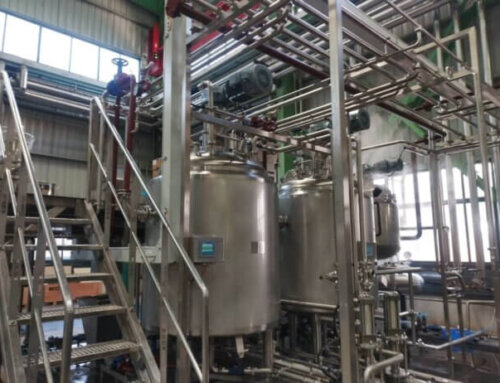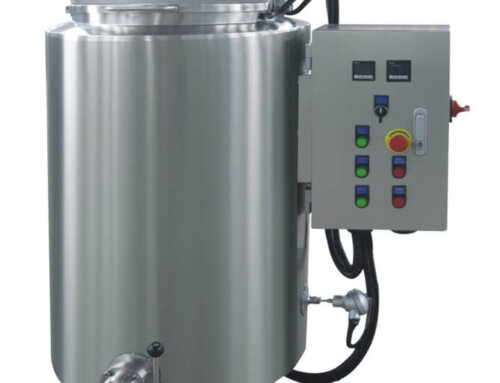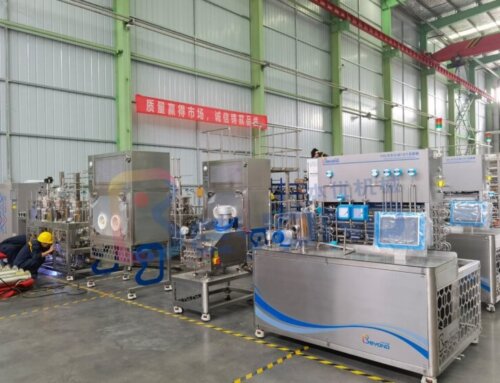For juice with meat or turbid juice, maintaining a uniform texture is very important to the quality of the juice. To stabilize the turbid material, it is necessary to reduce the precipitation rate to zero as much as possible. In order to stabilize the turbid juice, we should take the following measures: use homogenization, colloid milling treatment to reduce the particle volume; increase the viscosity of the dispersion medium by adding colloidal substances such as gum, xanthan gum, fatty acid glycerides, CMC, etc.; through high ester and hydrophilic pectin molecules act as protective molecules to embed the particles to reduce the density difference between the particles and the liquid.

Use thickeners
Thickeners are mostly hydrophilic colloids, and their main function is to increase the viscosity of the beverage. Cloudy juice beverages contain many tiny particles, and these particles will gradually settle during storage, leading to precipitation of the beverage. When a thickener is added to the beverage, the density of the beverage increases, and the viscosity also increases, which slows down the sedimentation speed of small particles and achieves the effect of maintaining the stability of the suspension of the beverage. Commonly used thickeners include xanthan gum and carrageenan.
Use Emulsifier
The solubility of turbid juice beverages can be divided into two categories: water-soluble and fat-soluble. These two types are generally immiscible. During storage, each phase gradually accumulates, the oil phase floats up and the non-oil phase sinks, leading to beverage layering. The emulsifier is an amphiphilic molecule. The two ends of the molecule interact with the water-soluble and fat-soluble components to keep the beverage in a suspended and stable state.
Adjust The PH Of The Beverage
When the pH value of the vegetable protein beverage system is near the isoelectric point, the solubility of the protein is minimal, and other components in the system are likely to aggregate and precipitate or float up. Therefore, adding salt to make the pH value of the system deviate from the isoelectric point is a necessary condition to maintain the stability of the vegetable protein system. There are two directions of deviation from the isoelectric point, that is, lower than the isoelectric point or higher than the isoelectric point. When the pH of the system is lower than the isoelectric point of the protein, that is, it is in an acidic environment, and the protective effect of most stabilizers colloids will be significantly reduced due to the decrease of the pH. At the same time, a low pH environment will promote protein denaturation during heat treatment, which is not conducive to the stability of vegetable protein beverages. When the pH value of the system is higher than the isoelectric point of the protein, the solubility and emulsification of the plant protein are improved, and the addition of various stabilizers to the system is also stable in this environment, which is beneficial to improve the stability of the plant protein. Usually use appropriate amount of citric acid, sodium bicarbonate, etc. to adjust the pH value of the beverage, and care should be taken not to negatively affect the taste of the beverage when adjusting.
Formation Of The Film
From the perspective of the dispersion system, the turbid juice beverage contains colloidal components. These colloids have different charges and are prone to agglomeration and sedimentation. After adding sucrose, protein and other ingredients, a film is formed on the surface of the colloid. On the one hand, this film can prevent the colloid from agglomerating, and on the other hand, it can increase the affinity of the colloid or fat globules with water, thereby enhancing the stability of the beverage. At present, white sugar or protein is added to many plant protein beverages and functional unsaturated fatty acid beverages, which not only improves the taste, but also enhances the stability of the beverage.
Use Chelating Agents
Beverages contain minerals such as calcium and iron, as well as many organic acids. After the two are mixed, precipitation is easy to form and separate from the beverage. After the chelating agent is added, it can reduce the effective concentration of a part of the metal ions and keep the beverage texture stable. Sodium citrate, sodium hexametaphosphate and phytic acid all have a certain chelating effect and can be used in beverage production.
Homogenization
Homogenization is a special operation in the manufacturing process of turbid fruit and vegetable juice or milk beverage. The purpose is to further refine the different particles in the suspension, so that the particle size is uniformly and stably dispersed in the beverage, and the uniform turbidity of the beverage is maintained. Turbid beverages that are not homogenized will gradually settle and lose their turbidity due to the large suspended particles under the action of gravity. At present, most high-pressure homogenizers are used to process turbid juice beverages. This homogenizer mainly uses a homogenization valve to allow the high-pressure beverage liquid to pass through an extremely narrow gap, usually at 60°C, between 18-20MPA, the suspended particles are crushed under pressure, and then due to the expansion and impact of the rapidly reduced pressure, the particles are refined and uniformly dispersed in the beverage. The homogenized material is below 2μm. According to the production needs, it can be homogenized many times.




